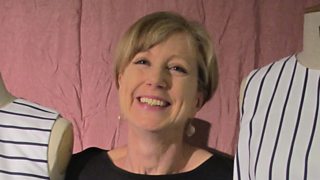2012 Finalists
The winner of So You Want To Be A Scientist 2012 was Val Waltham with her experiment about how fabric patterns affect size perception. Read about her experiment and the other four finalists experiments.
Isabel Thomlinson
- Occupation: A-level student
- Location: Shropshire
- Age: 17
Original Question: Why are some sounds so annoying?
Everyone has experienced the cringey horribleness of noises like nails on a blackboard. I want to know if there is a particular frequency at which the sound is most unbearable, and if this frequency depends on a person's hearing range, and therefore their age, or perhaps other factors like gender.
How would you research this?
Take a natural source of noise (e.g. cutlery scraping on plates, chairs scraping on the floor) and vary the objects used (size of cutlery etc.) to change the frequency of the sound. Ask a wide range of brave volunteers to listen to each sound being performed and rate them on unpleasantness.
Alternatively, synthesise a range of sounds with various frequencies, all based on the waveform of an existing horrible noise. Test on volunteers as before. Once unpleasant frequencies have been determined, you could test harmonics of them to see if they have the same effect.
Ìý
William Rudling
- Occupation: Illustrator
- Location: Leeds
- Age: 69
Original Question: Can you match the faces to the voice?
I'm a professional artist who is always looking at people's faces, i.e. caricature events or portraits. Over the years I've noticed people's faces with similar facial features will have a matching intonation in the sound of their voice. Does this mean the bone structure of the skull and muscle tissue influences the vocal chord? More akin to a musical instrument perhaps?
How would you research this?
I can give an example of my idea, Dame Judi Dench and Samantha Bond. Both have similar bone structure and facial features. Close your eyes and listen, then you'll see what I mean. An initial survey of other well-known would yield quick results.
Extra information
Future implications of the above submission may provide; A) 'sound map' that would compliment photo kit identities, B) Create more convincing artificial speech, C) Medical research?
Ìý
Dara Djavan Khoshdel
- Occupation: Student
- Location: Bournemouth
- Age: 24
Original Question: Can we measure the value of art?
I want to find out whether it is possible to predict the value of a painting (relative to other similar paintings) by measuring the galvanic skin response, or micro-sweating, of ordinary people when they view it. It would be particularly interesting to find out if abstract art which affects our limbic system, the emotional part of the brain, is the same art which sells well.
How would you research this?
To eliminate any interfering factors such as hype over an artist which might skew the results, I would have to find a group of paintings, all by the same artist, which were all sold at the same auction. Then I would sit the subjects in front of a screen, with their hands connected up to the pshychogalvanometer (a device which measures electrical resistance of the skin), display the paintings one at a time and measure the response. I would find an average reading for each artwork and make a league table which I would then compare with the sale prices.
Extra Information
Galvanic skin response is a measure of the electrical resistance of a person's skin. Skin resistance is lowered when you sweat and you sweat a tiny bit whenever something arouses your emotions. It is an un-fakeable measure of how a person is reacting emotionally to a stimulus.
Some abstract art is better than others, but few people can put into words exactly why; it's something we just feel. When people do put into words the value of a certain artwork, it often seems absurd, as anyone who's spent any time eavesdropping in galleries knows.
If it is true that good art is good art because it hits us on an emotional level, then it should be easy to measure which is the good art and which is the bad, by measuring the emotional response of people viewing it. If the results are positive, it would be a great thing for people like me, who are puzzled by the astronomically high prices paid for a Rothko or a Pollock. We would have an objective measure of the value of an abstract work of art.
Ìý
Val Watham
- Occupation: Organisational Consultant
- Location: Berkshire
- Age: 53
Original Question: How does fabric pattern affect size perception?
I want to find out the effect that different fabric designs really have on our perception of someone's size. I would take photographs of volunteers wrapped in different patterns of fabric (stripes, bold patterns, different colours etc. I would then stretch the picture and ask them to reset it to the correct size (as used in body dysmorphia studies). I could then measure how the pattern affected their perception.
How would you research this?
I would take photographs of volunteers wrapped in different patterns of fabric (stripes, bold patterns, different colours etc. I would then stretch the picture and ask them to reset it to the correct size (as used in body dysmorphia studies). I could then measure how the pattern affected their perception.
Extra information
I believe Peter Thompson's 2008 study used line drawings and cylinders and was restricted to stripes- I'd like to extend that and use real people. An alternative to using pictures of the person themselves could be to dress models in different fabrics and get the subject to make them the same size.
Ìý
Amateur Scientist Research Diaries
-
![]()
Follow Izzy's research diary on Facebook.
-
![]()
Follow William's research diary on Facebook.
-
![]()
Follow Dara's research diary on Facebook.
-
![]()
Follow Val's research diary on Facebook.




